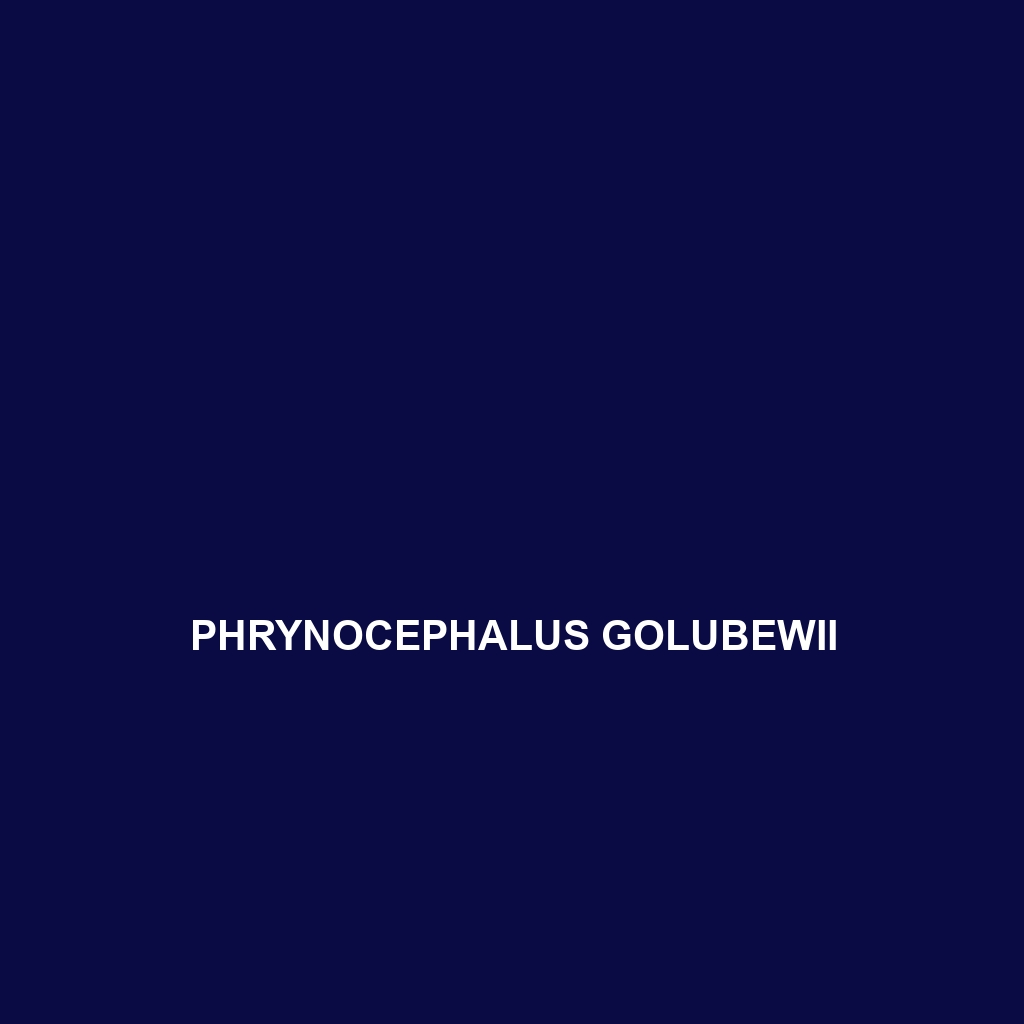Common Name
Phrynocephalus golubewii
Scientific Name
Phrynocephalus golubewii
Habitat
Phrynocephalus golubewii, commonly known as Golubew’s toad-headed agama, is primarily found in the arid to semi-arid regions of Central Asia, predominantly in territories of Mongolia and northern China. This species thrives in habitat types characterized by desert landscapes, sandy dunes, and rocky outcrops. The ecological systems in which Phrynocephalus golubewii resides exhibit relatively low annual precipitation, typically less than 250 mm, with extreme temperature variations. The lack of dense vegetation in these habitats often leaves small patches of grassy areas that serve as refuge and hunting grounds, contributing to the species’ adaptability and survival in challenging environmental conditions.
Physical Characteristics
Phrynocephalus golubewii exhibits distinct physical characteristics that contribute to its unique appearance. Adults typically grow to a length of about 15 to 20 centimeters. Their body is flattened and broad with a triangular head that further aids in camouflage against the sandy substrate. The coloration ranges from sandy beige to light brown, often featuring darker marbling which allows them to blend seamlessly with their environment. Their short, robust limbs and long toes equipped with fringed edges enable them to effectively navigate through sandy terrains. This ability not only assists with movement but also enhances their burrowing capabilities. The distinctive eyes and subtle markings on their dorsal surface are key identifiers of Phrynocephalus golubewii.
Behavior
The behavior of Phrynocephalus golubewii is quite fascinating and displays a range of adaptations consistent with survival in harsh desert environments. These lizards are primarily diurnal, engaging in activities such as basking in the sun during the day. However, they exhibit a pronounced defensive behavior called “crypsis,” during which they remain motionless to avoid detection by predators. When threatened, they may practice a unique behavior of burying themselves in the sand to escape danger. Mating rituals take place in the spring months, where males engage in elaborate displays to attract females. Vocalizations, head-bobbing, and push-up displays are commonly employed during these courtship behaviors.
Diet
Phrynocephalus golubewii is predominantly an insectivore, preying on a variety of small invertebrates including crickets, beetles, and ants. Their feeding patterns typically involve active hunting during the warmth of the day when insects are most active. These lizards utilize their keen eyesight to spot potential prey from a distance, often using a quick, darting motion to catch insects. Their dietary habits are crucial for maintaining the balance of their desert ecosystem, as they help control insect populations while also serving as a food source for larger predators within their habitat.
Reproduction
The reproductive cycle of Phrynocephalus golubewii is characterized by seasonal breeding patterns. The mating season generally occurs from late spring to early summer, coinciding with favorable environmental conditions. Females typically lay a clutch of 3 to 10 eggs, which they bury in the warm sand to incubate. The incubation period lasts approximately 4 to 6 weeks, after which hatchlings emerge fully developed and ready for independent life. Parental care is minimal, as the hatchlings must quickly adapt to the environment on their own. The early life stages of Phrynocephalus golubewii are critical, with survival heavily dependent on their ability to avoid predation.
Conservation Status
As of now, Phrynocephalus golubewii is listed as a species of Least Concern according to the International Union for Conservation of Nature (IUCN). However, habitat loss due to human activities such as land development and agriculture poses a looming threat to their populations. Conservation efforts are essential to ensure the long-term survival of this species in its native habitat. Protecting the integrity of desert ecosystems is crucial for the continued existence of Phrynocephalus golubewii and other endemic species.
Interesting Facts
One of the most interesting facts about Phrynocephalus golubewii is its ability to exhibit remarkable adaptations for desert living. These lizards can tolerate extreme temperatures and have developed a highly efficient method of thermoregulation, allowing them to maintain their body temperature despite blazing heat. Additionally, their ability to remain completely still and blend into their surroundings serves as one of the most effective survival tactics against predators. They have a specialized diet focused exclusively on insects, which makes them excellent controllers of pest populations in their ecosystems.
Role in Ecosystem
Phrynocephalus golubewii plays a significant ecological role in their desert habitat, acting as both a predator and prey species. As an insectivore, they help regulate insect populations, which is vital for ecological balance. Their presence assists in the health of the ecosystem as they contribute to the food web, supporting larger predators such as birds of prey and snakes. Moreover, by serving as prey, they help sustain diverse predatory species. This interconnectedness underscores the importance of conserving their habitat to maintain the overall stability of the desert ecosystem.
